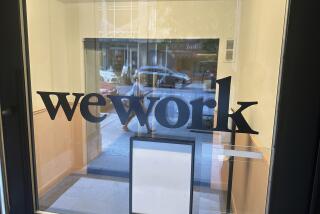Law Spells Out Who Gets Paid First : Bankruptcies: When companies go under, secured creditors and employees have high priority for getting paid.
- Share via
Chapter 11 bankruptcy filings such as the one made by retailer Carter Hawley Hale on Monday are designed to give a company breathing room while it reorganizes and works out agreements to pay creditors all or part of what they are owed.
Creditors often end up compromising, taking less than they are owed to resolve the case.
There are rules giving order to who is paid first, as set by priorities spelled out in the U.S. Bankruptcy Code. First, creditors are divided into two basic camps: secured creditors such as banks that have claims to specific assets--such as an office building--and unsecured creditors, or those with no such claims.
Because they have claim to a hard asset, secured creditors stand the best chance of getting their money back. When a company is forced to liquidate, the investments of common stockholders are often wiped out or they receive a small amount of money left over at the end.
A company in Chapter 11 continues to pay bills, with top priority going toward “administrative expenses,” those a company must pay to stay in business. That would include ongoing expenses for lawyers fees, accounting fees, payroll, supplies, rent, advertising and other services, provided that they occur while the company operates under protection of the bankruptcy court.
That does not mean that firms providing those services who were owed money when the petition was filed are entitled to get their money back immediately. They become unsecured creditors, placing them back in line with others seeking to recover money.
Employees are given high priority. Those owed up to $2,000 that was earned within 90 days of the date that the bankruptcy petition was filed are given very high priority. Payments on health plans and other employee benefit plans also are given high priority.
In the bankruptcy filing, Carter Hawley listed $452.9 million in secured debt, $350 million in unsecured junk bond debt and $582 million in unsecured “other liabilities,” which include accounts payable, taxes and capital lease obligations.
Carter Hawley Hale officials said late Monday that its secured creditors include Bank of America and Prudential Insurance. They did not say how much each was owed.
Among the 20 largest unsecured creditors listed in the bankruptcy filing, 13 appear to have supplied merchandise or concessions to the firm’s various stores.
The largest supplier debt on the list is $12.2 million owed to Brown Group Inc.’s Wohl Shoes Co., a St. Louis-based operator of shoe concessions in all of Carter Hawley Hale’s stores.
“It’s one of our largest accounts. . . . But we are planning to continue to operate. This clears the air of some of the uncertainty around them,” Wohl Shoes spokeswoman Mary Siverts said. She said the impact on her company would depend on whether and how quickly the bankruptcy court permitted payment of the $12.2-million debt, which largely reflects money collected from store credit accounts for shoes sold by the Wohl concessions.
The Los Angeles Times is the seventh-largest unsecured creditor on the list--the only newspaper in the top 20--and is listed as being owed $4.5 million.
“It’s too early to tell what the impact will be,” said a Times spokeswoman. “We expect them to reorganize. They are a valued customer, one of the biggest advertisers.” The spokeswoman would not disclose how much Carter Hawley Hale normally spends on advertising in The Times.
Carter Hawley Hale officials said Monday that their advertising would not be affected by the bankruptcy filing. But executives at some newspapers noted that advertising budgets at the retailer had been under pressure for some time and were optimistic that the company would be able to reorganize without further retrenchment.
A number of other newspapers in the West, including the San Francisco Chronicle, Oakland Tribune, Sacramento Bee and Arizona Republic, count Carter Hawley Hale stores--including the Broadway, Emporium and Weinstock’s--among their top advertisers.
The struggling Tribune in Oakland counts Emporium as its largest advertiser. The 10-month shutdown of, and resultant halt in advertising by, Emporium in downtown Oakland after the October, 1989, earthquake proved very damaging to the paper, which has cut its staff and salaries in recent months in a desperate effort to stay afloat.
Tribune officials could not be reached for comment.
The largest unsecured creditor is Security Pacific National Bank, but the Los Angeles-based institution appears only as trustee for $350 million in bonds that belong to holders other than the bank. The second-largest creditor is Neiman Marcus Group Inc., which might be owed $14.3 million if a court ultimately rules for that company in a dispute over tax liabilities related to its spinoff from Carter Hawley Hale in 1987.
Several of the biggest creditors were major suppliers. Among such companies, cosmetics supplier Estee Lauder Inc. is listed as being owed $7 million, clothing maker Liz Claiborne Inc. is owed $5.4 million and electronics company Sony Corp. is owed $2.6 million.
Another major Southern California creditor is Belkeith jewelry, a Toluca Lake concessionaire that appears to operate jewelry counters in at least some Carter Hawley Hale stores. Belkeith President Allen Belgard did not return a call seeking comment on a $7.8-million debt owed to Belkeith.
Times staff writer Michael Cieply contributed to this story.
CHH’S LARGEST UNSECURED CREDITORS Security Pacific Bank,* Los Angeles: $225 million
Security Pacific Bank,* Los Angeles: $125 million
Neiman Marcus Group Inc., Dallas: $14.3 million
Wohl Shoes, St. Louis, Mo.: $12.2 million
Belkeith Jewelry, Los Angeles: $7.8 million
Estee Lauder Inc., New York: $7 million
Liz Claiborne Inc., New York: $5.4 million
Los Angeles Times, Los Angeles: $4.5 million
Bethco, New York: $3.9 million
Cole & Weber, Seattle: $3.5 million
* Money is not owed directly to the bank. It is the trustee for junk bond issues.
Source: Bankruptcy court petition
More to Read
Inside the business of entertainment
The Wide Shot brings you news, analysis and insights on everything from streaming wars to production — and what it all means for the future.
You may occasionally receive promotional content from the Los Angeles Times.










